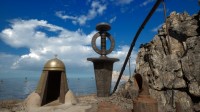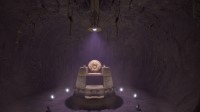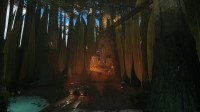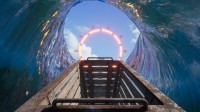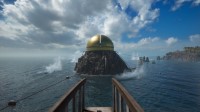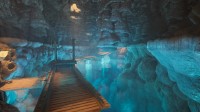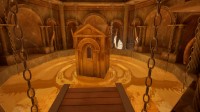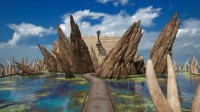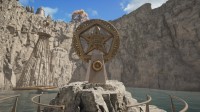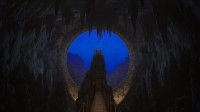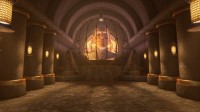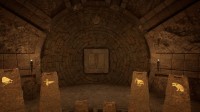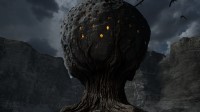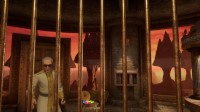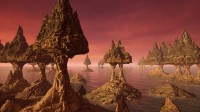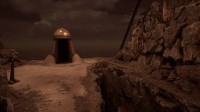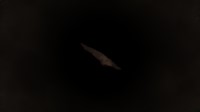Riven (2024)
Playtime: 8.8 Hours
Finished 14 July 2024.A fairly standard playthrough of the game, trying to make the most of the 3D movement and camera. I played the original game pretty recently, so I had some pretty good general impressions of the structure of the game - particularly how the concept of a few huge puzzles spread across a single age was a significant departure from the more bite-sized pieces found in the original Myst. Revisiting the atmosphere of the world and the story was definitely a joy though, and while I knew the secret to the confrontation with Gehn those moments still felt quite special. I ended up getting the "best" ending, ie. the one where you actually do what you're supposed to do. I might consider playing this game again someday, probably alongside the 2021 remake of Myst; I think these first two games form a fantastic self-contained duology.
After over 25 years, Riven finally receives the remake it deserves! Although the game is pretty much forced to forever live in the shadow of the original Myst, I think in many respects it represents a massive leap forward in the series. It didn't revolutionize the industry in the same way that Myst did in the years prior, but features a beautifully crafted world and incredibly well thought-out puzzles, set almost entirely in the confines of a small, dying world with a surprisingly deep backstory set in the backdrop. Where the original Myst feels like a game designed around the concept of a point-and-click adventure, Riven felt more like a game designed with a purpose to close out the ambiguous ending of Myst. As I've already mentioned in my comments of the original (1997) release of Riven, I think Cyan accomplished this incredibly well. Amongst enjoyers of the entire Myst series, Riven is extraordinarily well regarded; it seems to place even above the original Myst, and I can't disagree.
To avoid too much of a risk of repeating things that I've already mentioned before, I'll try to focus mostly on the major changes of the remake. The graphical improvements are the most obvious, but don't require too much discussion; the aesthetic of the original was already presented well enough to let my mind fill in the rest of the gaps, but I can't deny how magnificent the scenery and atmosphere are in this version. With that said, I also can't think of any specific scenes during my playthrough that were especially memorable compared to the same places in the original... the underwater minecart ride maybe? The human characters also look a little bit less offputting than in the most recent Myst remake in my opinion, but they are again such a small part of the game that it isn't a huge concern either way. Notably, I thought the Gehn scene was fine with the 3D model instead of the original FMV, though I really wish John Keston's acting could have been used in some way. Beyond that, it's just barely worth noting that this game also supports VR and uses manual movement and free camera controls - similar to the Myst remake and all of Cyan's other recent releases - the purely point-and-click adventure is just about dead as a genre nowadays.
The most interesting changes are necessarily the mechanical differences in the new game, especially when considering the fully-interactive nature of the environment. A major consideration when developing any of these conversions is that perspectives are no longer fixed, making it harder than before to draw a player's eyes to a specific view of a scene in motion; a small example of this off the top of my head is the golden beetle at the forest gates when first visiting Village Island - it's a separate scene/shot in the original game, but you have to walk right into the wall and actively stare at it to even notice it in the new game. I think there are also a number of buttons and mechanisms that can be a bit difficult to spot when approaching areas in this game. These situations are again caused by the fact that the original game could force you into certain positions AND perspectives forced by the designers, while the free WASD movement eliminates that possibility in this game. At the end of the day, though, I don't think it made too big of a difference to me personally. Perhaps I'd think differently if I went into this completely blind before playing the original.
Several of the puzzles have also been significantly changed as well - and for the better, in my opinion. Like the Myst remake, many more of the puzzles are randomized (numbers, combinations, etc.) - I don't know if there's a way to turn that off and have the solutions behave the same (and I don't care either). The two key puzzles in this game (namely the Fire Marble and Standing Stone puzzles) are the same in concept, but many of the individual parts have been significantly changed. The Village Island animal symbols now make use of a special Moiety looking-glass device that reveals hidden "paintings" or symbols in the terrain, in addition to the key hints of the numbering system used to order them when inputting the Standing Stone code. On the other hand, the Fire Marble puzzle has the player actually enter the Starry Expanse through each island's dome in order to transfer the powered marbles to the central temple, eventually enabling access to Age 233. For convenience, there's also a backdoor into the Moiety chamber on Village Island now as well, though there's not much of a reason to use it. Lastly from what I can immediately recall, a very nice new addition is the ability to actually see a bit more of Tay and Age 233, which you were able to visit but not to explore in the 1997 release. It's not a huge expansion, but just enough to implant a bit more life into those worlds.
I wish Cyan had realized many years earlier how integral Riven was to the development of the Myst universe, instead of focusing entirely on Myst for all these years. That said, they certainly did not fall short of what I hoped for when they first hinted at this last year - I think this remake is a triumph in pretty much every way I can consider, being a fantastic game that stays very true to the original vision while tweaking and improving things to be not just acceptable, but very fun for a modern game too. (BTW I have no idea if it's as good in VR.) Naturally, there will always be a group of people that see anything outside of the original 240p stills and grainy FMVs as an affront to their beloved classic, but I honestly cannot agree for this one. For whatever price paid, I think this game was absolutely worth it; somehow, finishing it gave me a satisfaction reminiscent to my first time beating the original RealMyst probably ~15 years ago. Maybe someday they'll turn their eyes towards the rest of the series.
